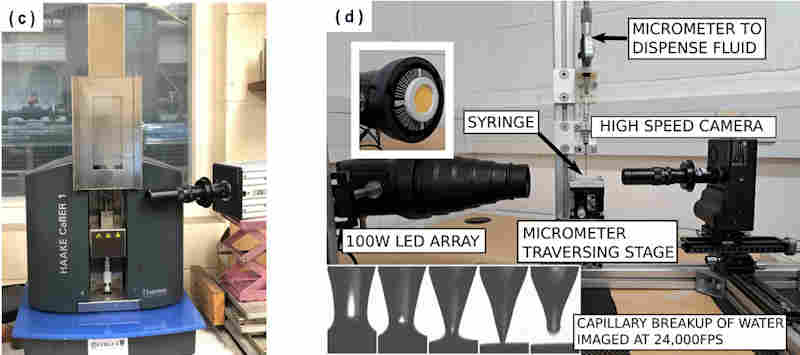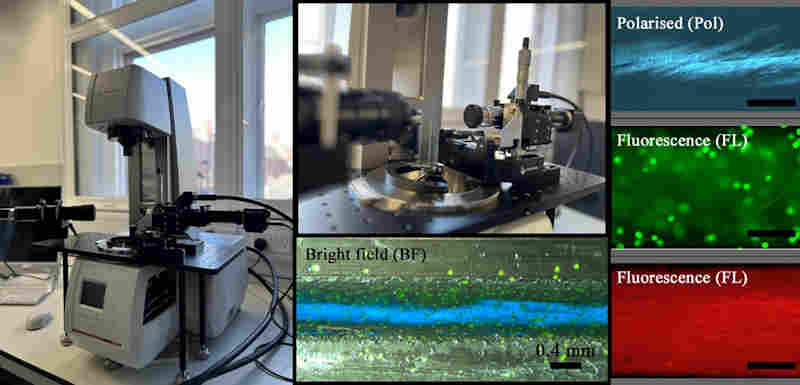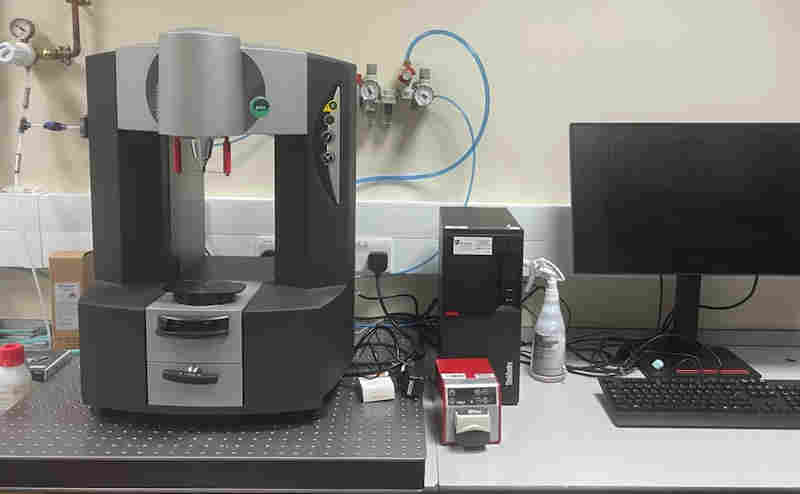Here you can find an overview of capabilities and technical specifications. Contact us to discuss your needs or interests.
Contact information:
Professor R J Poole (robpoole@liverpool.ac.uk)
Dr Esther García-Tuñón (egarciat@liverpool.ac.uk)
Dr Anders Aufderhorst-Roberts (Anders.Aufderhorst-Roberts@liverpool.ac.uk)
Fluids Laboratory
Rheology Laboratory

Description: (A) commercial Anton Paar MCR302 torsional shear rheometer (B) commercial TA Instruments AR-1000N torsional rheometer.
Capabilities: steady shear viscosity, unsteady shear viscosity including “step” shear and oscillatory shear. Total thrust measurements allow simultaneous measurement of N1 (cone geometry) and N1+N2 (parallel plate). Suitable for fluid-like materials with viscosities ranging from 1m Pas (water-thin) to 100 Pa s
Materials: polymer solutions, wormlike micellar fluids (shampoo, conditioners)
Geometries: for TA only: Double Concentric Cylinder device
for both rheometers (smooth unless stated)
- 60 mm 2 deg acrylic cone
- 50 mm stainless steel plate
- 40 mm acrylic plate
Temperature range: both use a Peltier plate to control to within +- 0.1 °C. Possible range 5-95 °C Most effective range close to room temperature (solvent trap available).

Description: (C) A commercial HAAKE™ CaBER™ 1 and (D) a bespoke dripping-onto-substrate (DoS) extensional rheometer augmented with high-speed imaging setups to yield apparent material properties of non-Newtonian fluids under uniaxial extensional flow.
Capabilities: characterise the extensional rheology of solutions with apparent extensional viscosity as low as 1mPa s.
Advanced Materials Processing Laboratory, George Holt Building
Formulation and Rheology Laboratory
Anton Paar MCR702e Multi Drive Rheo-Optics setup

Description: multi-drive system in which both air-bearing-supported motors can be used as drive units and torque transducers. The movement of each plate can be independently controlled. This setup can be used to create a fixed stagnation plane in a sample or counter-movement mode to reach a higher shear rate range. Two rheo-optics setups enable imaging in bright field, polarised and fluorescence microscopy.
The current setup is suitable for a wide range of materials (emulsions, gel, pastes, suspensions, etc.).
Geometries: diverse set of cone-plate and parallel plates with diameters between 25 to 50 mm, and with different surface-finished (stainless steel sandblasted, and smooth quartz).
Temperature range: Peltier plate and hood can be controlled in the range -20 to 200±0.1 °C (currently not compatible with rheo-optics).
Capabilities: 1 nNm minimum torque for low viscosity samples in rotation, 230 mNm high torque value for stiff samples. Up to 50N normal force. 5x, 20x and 50x microscope objectives, linear polariser in bright field, and two fluorescence band passes.
Kinexus PRO Rheometer, Highway Lab, Brodie Tower

Description: commercial Kinexus PRO Rheometer
Capabilities: Suitable for all rotational shear-based testing on solid-like viscoelastic materials, like bitumen, polymers and elastomers, dairy products, adhesives, etc.
Standard operating modes direct strain control; shear rate control; shear stress control.
Torque range – Oscillation (strain and stress control): 1.0 nNm - 225 mNm
Frequency range: 6.28 μrads-1 to 942 rads-1 (1 μHz to 150 Hz)
Normal Force range: 0.001 N - 50 N
Geometries: 4 mm, 8 mm and 25 mm parallel plates specifically designed for Asphalt testing.
Gap resolution: 0.1 μm
Temperature range: Active Hood Peltier plate cartridge. Temperature range -40°C to +200°C.
Most effective range 0 to 100 °C.
Maximum heating rate* 30°C/minute
Maximum cooling rate* 20°C/minute
Temperature resolution 0.01°C
KINEXUS Prime ultra+Rotational Rheometer, Bioengineering Lab, Walker Building Tower

Description: commercial Kinexus Prime ultra+ Rheometer
Capabilities: Suitable for all rotational shear-based testing on soft and low viscosity viscoelastic materials such as biological materials, suspensions, polymers, gels, surfactants.
Rheodialysis accessories for simultaneous chemical and shear perturbation of samples.
Capabilities for in situ visible light curing.
Standard operating modes Direct strain control; Shear rate control; Shear stress control
Torque range Viscometry: 1 nNm to 250 mNm
Torque range Oscillation: 0.5 nNm to 250 mNm
Torque resolution 0.05 nNm
Frequency range: 6.28 μrads-1 to 942 rads-1 (1 μHz to 150 Hz)
Normal Force range: 0.001 N - 50 N
Geometries: Large range of 20, 40, 50 and 60mm parallel plates and cone-plate (1-4° angle) geometries with a range of surface roughness properties to mitigate sample slip. PEEK polymer geometries for high pH environments.
Gap resolution: 0.1 μm
Temperature range: Active Hood Peltier plate cartridge. Temperature range -5°C to +150°C.
Most effective range 0 to 100 °C.
Maximum heating rate* 30°C/minute
Maximum cooling rate* 20°C/minute
Temperature resolution 0.01°C
Back to: School of Engineering